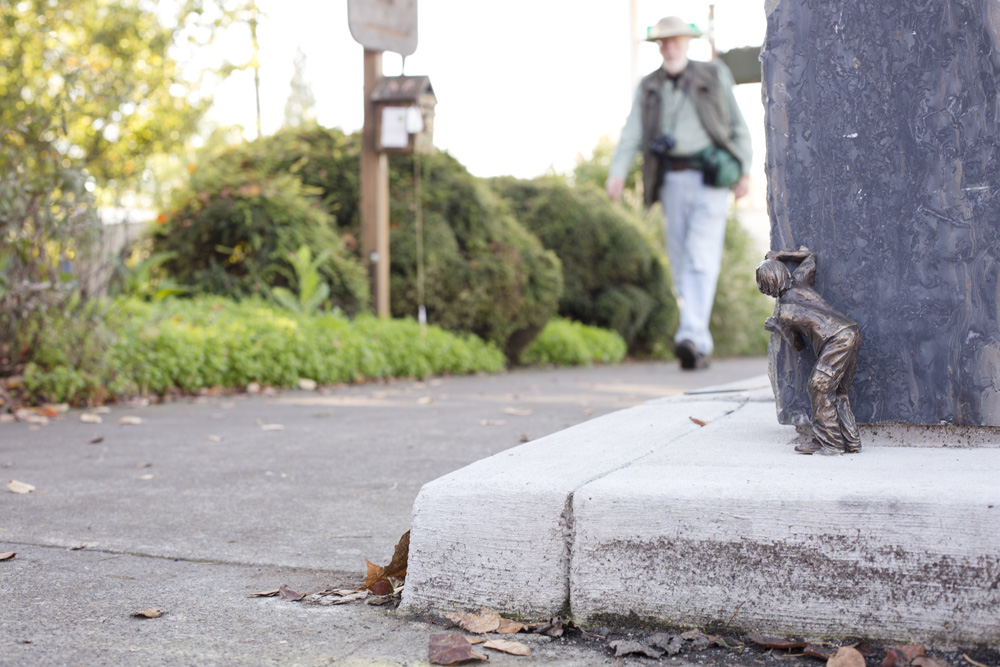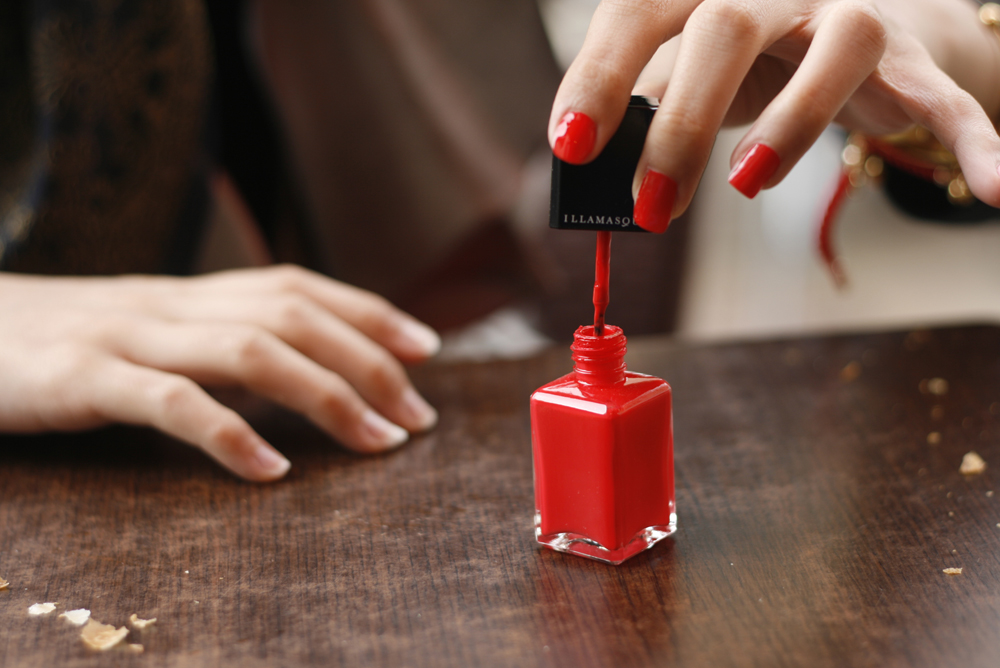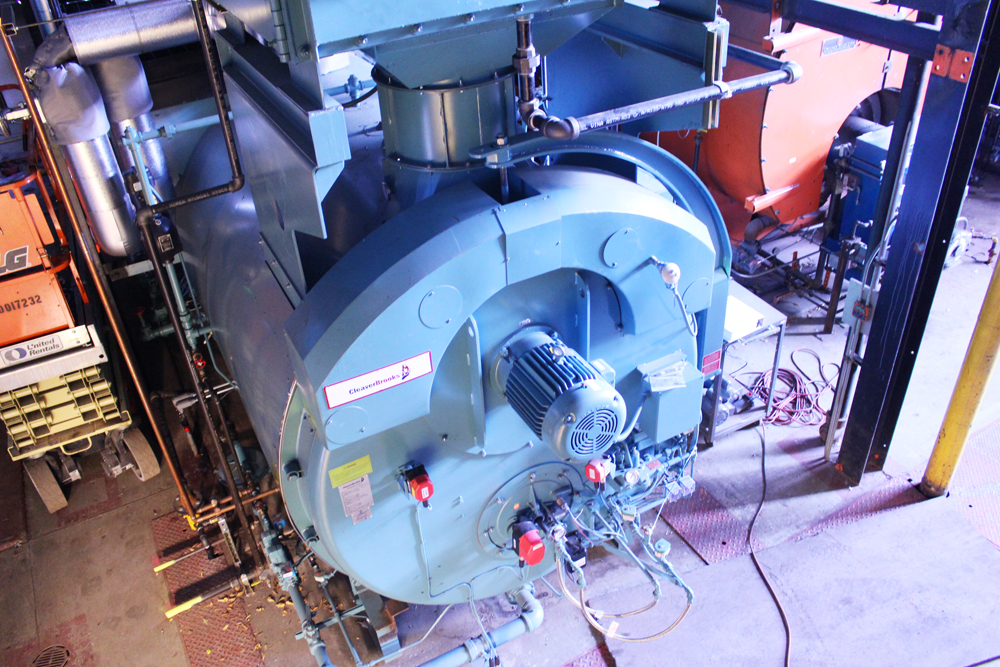To have art displayed in public is a significant achievement. To have an entire city call to display your art is an even greater honor. That honor was recently bestowed upon one Portland couple on Oct. 24, at the grand opening ceremony for This All Happened More or Less, a permanent sculpture installation by Crystal Schenk and Shelby Davis.
The ceremony was held on the newly renovated Southeast Division Street, where the installation can also be found. The installation itself is composed of miniature sculptures that depict people in daily life. The sculptures themselves are scattered across several blocks of Division Street.
Schenk and Davis, a husband and wife team, received their respective Masters in Fine Arts at Portland State in 2007 and 2008. They have been working on joint projects since 2009, but each have had their own projects and pursuits under their own names.
This is their first public art commission.
“We applied for it right before we got married, found out they wanted us to do the proposal and worked on the ideas during our honeymoon,” Schenk said.
Both Schenk and Davis come from creative families. They enjoy the physicality of sculpture and being able to convey their ideas through something tangible.
“Instead of me sculpting one and [Davis] sculpting another one, we’d start one and then trade back and forth,” Schenk said. “It was a continuous process of adding, editing and subtracting.”
Davis said it was challenging not to become attached to his work as the two traded roles.
In the process of constantly trading off, the figures evolved into ideas that were completely different from the original plan. Davis said that seeing characters change and seeing precise details come together was a good thing.
This All Happened More or Less was funded by Portland’s Percent for Art ordinance, under the Regional Arts and Culture Council. The ordinance requires that 2 percent of public money generated for construction projects be set aside for the creation and maintenance of public art.
To choose a project, the RACC assembles a board of planners and artists who accept open submissions. When the board selects their top choices, those artists must present a specific proposal for the city. This is how Schenk and Davis were selected after they applied for the grant three years ago.
The project came about alongside streetscape improvements to Division Street. Within the past 10 years, This All Happened More or Less has been one of hundreds of art installations permanently displayed throughout the city thanks to this ordinance.
A great deal of trust and compromise was exchanged during the process.
“One of the things that interests Shelby and I, in a lot of our work, is suggesting a story but not finishing it,” Schenk said. “There is something about letting people use their own imagination that makes it more interesting.”
Eight bronze sculptures are scattered along Southeast Division Street, figures all telling a different and ambiguous story. They are isolated, and their few details give the public enough to reflect on, letting viewers imagine each sculpture’s fate.
Inspiration for the title came from people Schenk and Davis had actually met: friends, family and strangers. They later fictionalized the identities of their subjects in order to convey the core idea of This All Happened More or Less.
“It’s boring when you’re spoon-fed everything,” Davis said, “and we’re always looking at strangers and wondering what their stories are.”
Schenk and Davis also heavily explored Division Street, getting to know the history, atmosphere and local quirks that would later spark ideas for the project.
Schenk said the figures are decidedly more conventional than other projects she has worked on. Yet with their smaller-than-life scale and commonplace poses, the intimate monuments are approachable in their own way.
“Figurative works are rare and people get excited to see them,” Davis said. “It’s something they can relate to.”
Admirers walking by have felt comfortable emailing the couple with anecdotes or photos of themselves posing with the sculptures.
“Art understood by artists is very different from art understood by the public. This particular project is very accessible to the public. We really wanted to connect it back to the community,” Schenk said.
For viewers, location makes all the difference in how they experience art. A gallery is inherently different from a public work of art displayed on a sidewalk. Many gallery shows are regimented, with the experience focused on hung art or static displays. The viewer enters a gallery, has a specific preconceived experience and then leaves, cutting ties with the art.
Yet when that artistic experience is conveyed in public, it takes that familiar public space and makes it personable. This could explain the emails and photos Schenk and Davis have received in response to their highly visible art. That is, after all, the RACC’s mission: to install art that the community will feel invested in.
The moments leading up to success, however, are not easy. Artists know this to be especially true.
According to Ethan Seltzer, interim director at the School of Art and Design and longtime professor, artists are some of the most business-oriented people in the industry.
“Artists are extremely entrepreneurial. They constantly need to be figuring out a way to map out a path with their chosen career interests.”
This sentiment, however, also applies to anyone pursuing a less traditional path. The goal is to find any connection between your passion and a job that will provide you with your basic needs.
Schenk and Davis are artists, but both also serve as adjunct professors at the Pacific Northwest College of Art, the Art Institute of Portland and PSU.
One thing that Seltzer and Schenk both agree on is the importance of perpetual passion.
“Students know it will be hard to find a job as an artist, but this makes them more passionate. Do the things that help you remind yourself why you got into it in the first place. If it’s important, show it,” Seltzer said.
Seltzer said he believes that PSU is becoming a school that garners more recognition and support for the arts.
Schenk is equally inspired by passion, and doesn’t allow herself and Davis to be defined by failure.
“When you get those rejections it’s easy to be discouraged, and it’s easy to think I’m not going to make it,” Schenk said.
Schenk said to be an artist involves a driven and hungry personality, and the ability to work very hard. Yet the motivation to pull out of rejection has always paid off for the couple, who plan to apply for more commissions in Portland and beyond.
“I guess if you just love something so much, you do it no matter what,” Schenk said.
A walking map for This All Happened More or Less, which marks the location of all the installation’s sculptures, can be found on Schenk and Davis’ website crashstudioart.com.





